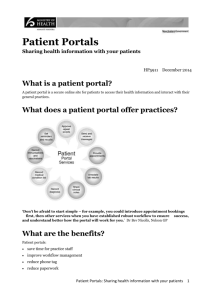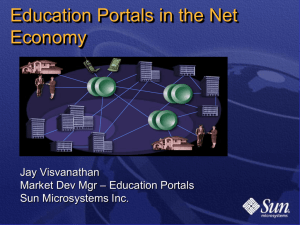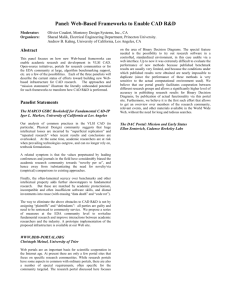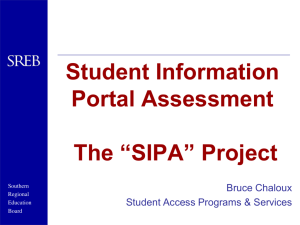UniversityofMaine
advertisement
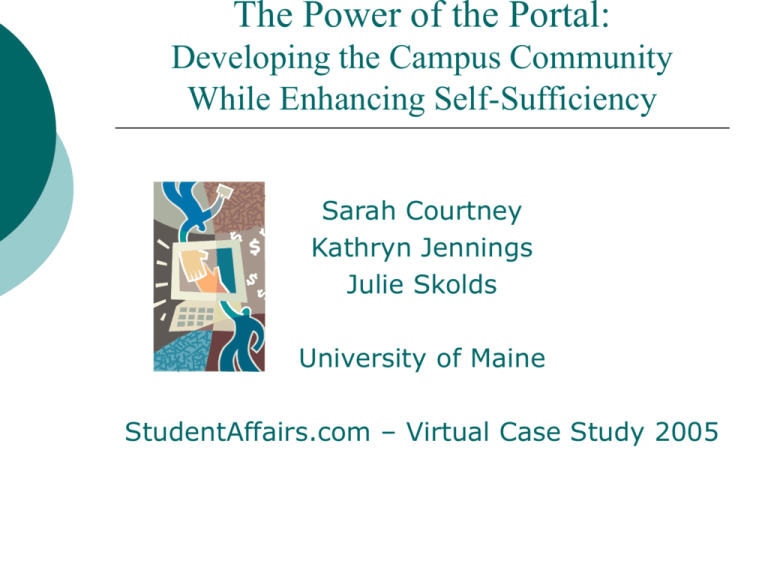
The Power of the Portal: Developing the Campus Community While Enhancing Self-Sufficiency Sarah Courtney Kathryn Jennings Julie Skolds University of Maine StudentAffairs.com – Virtual Case Study 2005 What Is a Portal? “ …an entrance or doorway…You could think of a portal as a starting place for people to begin their cyberjourney” (Dominick, Sherman, & Messere, 2000, p. 132). “…a personalized collection of information, content, and services” (Pickett & Hamre, 2002, p. 37). “…an online service that provides a personalized, single point of access (single sign-on) to resources that support the end-user in one or more tasks (resource discovery, learning, research, etc.) The resources made available via a portal are typically brought together form more than one source” (http://www.usask.ca/web_project/uwebd/portals_faq.html, retrieved on February 16, 2005). Vertical Enterprise Portals For the purpose of a higher education institution, a vertical portal should be used. They are designed to support: Specific functions Processes Applications All must be tailored to the individual user. (Collins, 2003, p.34) Contains: My Front Page Channels Navigation links Advanced search capabilities Directories Graphics Alerts “A VEP is a portal that delivers organizationspecific information in a user-centric way” (Strauss, 2002, p.36 + 38). The Impact on Student Affairs: “We can use technology to communicate with students, ‘customize’ our interactions with them without being restricted by time or place.” “Technology can enable us to make students more knowledgeable about the many resources available to them, and provide needed information when they encounter a problem.” “We can use technology to make our service, programs, and facilities more efficient and userfriendly.” (Upcraft & Goldsmith, 2000, pp.224) Why a Customized Portal? Will offer advanced search technology that enables the student to have immediate and easy access to information pertinent to their college experience To enhance the university’s image Maintain alumni network Improve administration efficiency Integrate and streamline information and services Enables more efficient use of an individual’s time Allows customization to meet each individual’s needs Create and reinforce university communities, enhancing the experience of the individual, resulting in stronger ties to the campus community (Katz, 2002) (Pearce, 2003, p. 63) Why a Customized Portal? (Cont.) “Compelling reasons to develop a portal are that an increasingly internet-savvy student body expects it, and the horse is already out of the barn” (Daigle & Cuocco, 2002, p.112). “Portals provide views of the institution that reflects an individual relationship at various stages of his or her life” (Daigle & Cuocco, 2002, p.113). Portals at Smaller Institutions: Need to be smaller than those at large schools The community is smaller and so the portal should be smaller Foster a more personal learning environment Small schools already have the luxury of small class rooms, the ability to group work, and time and attention from faculty. Portals can only increase this personalized education, by allowing students to interact with classmates and teachers outside classroom, through postings, updates, and interactive chats Empowers students to do things for themselves making them active participants in their college career Increase attendance at events, including sporting events, by creating a buzz and getting students to discuss upcoming events over the computer Planning and Implementation Teams: Member Recommendations Current Members Director of Residence Life Representative from Office of Communications President of Faculty Senate New Members A female and a male student Representative from the Office of Research, Assessment, and Planning Classified Staff Member Representative from Alumni Relations Dean of Students Phase One: Ellingsburg University Goals for Intranet Portal Improve access to college information through a self-service user friendly, personalized environment Aid in the development of a personalized niche for each student, by facilitating easier access to information, events, and others with the same interests Promote constant communication, data sharing, and support between university departments and faculty Create a continuous and inclusive connection among alumni and the university Google Search EU Search Recommended Channels EU Sports ME: My Ellingsburg EU Headlines Directories My Student Organizations Faculty/Staff/Dept./Students EU Library Local/National/ World Headlines Academic Calendar Today at EU Dates to Know My Playlist Listings Payroll My Links Breakfast Lunch Dinner Today’s Menu Account Balance Dinning Service Personal Calendar Student Records Student Employment Registration Tuition Statement Grades DARS Financial Aid Status Change of Address Hours Ask a Librarian Circulation Record Library Search Class Schedule Title Instructor E-Reserves Display Textbooks Buy Textbooks Channels Chosen Because: Accurate representation of what the students will need and want to have the option of having on their personalized web page Want the functions to fit the institution and give the university community easy access to important information through self-service Encourage community building by allowing community members to personalize content, therefore taking ownership of their identity and level of commitment to the university Keep Ellingsburg University building at a competitive pace with larger and more elite institutions Gathering Feedback: Design a web based survey using Survey Monkey to get an idea of what is wanted in the portal Administer survey through campus e-mail incentive Anonymous suggestion box in dining hall and student union Focus Groups when a mock up of proposed portal is finished to get feedback on further changes; dinner will be provided to those who attend: Student focus groups will be run by the students on the committee Faculty focus groups will be run by the faculty senate member on the committee Staff focus groups run by staff member Technology Based Systems Ellingsburg Should Use: Single-sign on portal system WebCT for courseware development and delivery First Class Higher Education for student web access, messaging and calendar services Oracle Portal for Intranet development Oracle Database and Applications for electronic forms and workflow Security Issues “Colleges and universities must strive to achieve what technologists refer to reverentially as ‘single sign-on’.” “These systems need to be secure and to handily recognize an individuals authorizations, based on roles and other personal attributes.” “In essence, the information system must be able to know “up front” that John Doe is really John Doe and that Dr. Doe is a tenured faculty member.” (Katz, 2002, p.11). Portals are doorways to a wealth of information, therefore they are susceptible to the threat of hackers. When different application systems (FirstClass, Oracle, and WebCT) are integrated, the task is to remember to also integrate security amongst the programs in order to protect the entire portal. (Sullivan, 2004, p.56+168) ME My Ellingsburg ME Log In: Enter Id: Enter Password: Register if this is your first time to the online community. For help with ME, call IT Help Desk at 555-5555 or e-mail ithelpdesk@ellingsburg.edu ME My Ellingsburg Search Hello, Student WWW Friday, February 18, 2005 EU Headlines EU Sports Local/National/World Headlines Breakfast My Playlist Daily University Update Lunch My Links First Class Dinner Account Balance Moose Card Academic Calendar Today at EU Dates to Know Add Drop Registration Financial Aid Student Records: As Of 1204.67 Personalize Content www.Ellingsburg.edu The Moose Menu Weather Powered by the Weather Channel Help | EU Homepage | Log Out 02/20/05 Registration Grades Tuition Statement DARS Financial Aid Change of Address My Activities: EU LIVE WEB CAM: Directories: Library: Circulation Record Library search Departments Faculty / Staff Library Information Students Student Employment: Ask a Librarian? Job Opportunities Payroll My Class Schedule: CRN Course # Title Days Times Location Instructor 1012 101 Intro. to Biology M, W, F 10:10 – 11:00 BLD Susan Peabody Student Health Services: Insurance Relay Health E- Reserves Link to Buy Textbooks Office Information ME My Ellingsburg • Student’s • Link to academic • Local Weather name calendar Search | EU Homepage | Log Out • EU • The daysHelp campus Hello, Student Newspaper events WWW www.Ellingsburg.edu headlines • Important datesPersonalize to Content Friday, February 18, 2005 • Show daily •Sports Scores remember such as menus • Personalized those shown Playlist linked Academic Calendar Weather Powered by the Weather Channel The Moose to ITunes • Interactive Menu • Favorite EU Headlines Local/National/World Today at EU calendar linked Bookmarked to First Class Breakfast EU Sports Headlines Dates to Know websites Lunch • Headlines My Playlist Daily University Update Add Drop from their Registration Dinner First Class My Links favorite news • Real Time Financial Aid sites Update of • University left on • All links to Account Balance As money Of Student Records: Notices University Card important Registration • Link to First documents Grades Moose Card 1204.67 02/20/05 Class • Links to Tuition Statement DARS organizations Financial Aid Change of Address EU LIVE WEB CAM: student is My Activities: • On screen involved with library hours andDirectories: • Live web notifications cam Library: Faculty / Staff Departments • Link E-mail updating Circulation Library librarian with pictures Students • Search engines Record Informationquestions from for directories campus Student Employment: Library search Ask a Librarian? available on • Real time update of regularly page books borrowed by Job Opportunities Payroll students with due dates My Class Schedule: • Library search • Listing of job • Link to CRN capability Course from # Title Days opportunities Times on Location Instructor • Link to syllabus students page their front page instructors • List the Student Health insurance and show payroll web page dates, and pay student has Services: • Link to stubs • Log in to • Link to 1012 Intro. to M, W, F 10:10 – BLD Susan articles on 101 Relay Health Bookstore Insurance Biology 11:00 Peabody syllabus service to buy Relay Health • Office textbooks hours and Office Information E- Reserves Link to Buy Textbooks notifications Phase Two: Faculty, Staff, Alumni Portals The committee proposes beginning the project with the student portal, but in order to complete the goals stated earlier encourages the creation of faculty, staff, and alumni portals to soon follow. Recommended Channels Faculty/Staff Messages from Various University Offices ME: ME My Ellingsburg EU Headlines Directories Google Search EU Search Human Resources Employment Opportunities Training HR News and Events Faculty/Staff/Dept./Students EU Library Local/National/ World Headlines Academic Calendar Today at EU Dates to Know Office of the President Office of the Provost My Links Student Employment Personal Calendar Employee Records Listings Payroll Information Breakfast Lunch Dinner Dinning Service Today’s Menu Change of Address Pay Stubs Tax Forms Insurance Plans Retirement Plans Hours Ask a Librarian Circulation Record Library Search Class Schedule Benefit Forms Compensation Forms Tuition Exemption Family Services Title Student Rosters with contact information and direct e-mail link E-Reserves Order Textbooks EU Sports Alumni news EU Headlines Recommended Channels Alumni Google Search EU Search ME: ME My Ellingsburg EU Library Department received degree in Hours Ask a Librarian Circulation Record Library Search Directories EU Bookstore Faculty/Staff/Dept. Career Services Order Merchandise Events Services Volunteer Opportunities Transcript Order Forms Medical Center Order medical file Best Practices: Presentation: Usable Format Personalization: Raises Efficiency and Comfort Level Interactive Layouts Consistent Look and Feel Framework: Effective On-line and Off-line Tools, While Encouraging Action Based on Each Person’s Role Platforms and Programs that Evolve with the Needs of the Institution Creates personalized community Integration: Use of Various Databases Lowers Operating Costs (Duffner, 2001, p. 2) My UW: An Exemplar Educational Portal The following slide is the front page to the MyUW student portal at the University of Washington. After reviewing several portal cites from institutions of higher education, we found that MyUW’s cite was the one we consistently returned to. We liked its organization, channel content, and aesthetic look. It was not too crowded and not too bare. Even though UW is a large university, we found that we were able to utilize their cite for inspiration for our small liberal arts school. Portals at Smaller Institutions Challenges: In order for a portal to serve the community as intended, universities need to make investments and changes in: Information Technology Institutional policies Portals complicate who has access to what info and why, which may lead to questions as to who is a member of the community. Policies will need to be created to address outside advertising. (Katz, 2002, p.12) Portals at Smaller Institutions Challenges (Cont.): How will student information be used to populate alumni profiles? (Katz, 2002,p.12) Difficulty getting everyone on campus to accept a campus-wide technology initiative (Grant & Anderson, 2002, p. 23-32) Universities must make extra efforts to ensure that the portal stresses community building to help build and not break down loyalty (Katz, 2002,p.12) Technology on campus also brings its own set of legal concerns, computers create: New privacy concerns Potential copyright disputes Free speech concerns (Kaplin & Lee, 1995, p.9) Portals at Smaller Institutions Challenges (Cont.): “Small campuses may not have the staff to provide sophisticated applications and a dynamic web presence” (Barratt, 2003, p.381). “Automation, paperless transactions, and one-stop selfservice shifts greater responsibility and participation in administrative services to the customer, and this changes the need for labor as well as the division of labor within the organization” (Kvavik, 2002, p.66). Staff, Faculty, and Administration Small schools tend to have more staff, faculty, and administration who wear multiple hats. Attention to updates to the portal and requests from the portal may tax an already overwhelmed staff. Staff, faculty, and administration charged with these tasks will need good training and a large and supportive IT department. ME: The committee concludes that Ellingsburg University will benefit greatly from the implementation of a portal that is sized to the institution, configured to the needs of the university’s population, and fosters the Ellingsburg commitment to community. This project will bring Ellingsburg up-to-date with the technological advances in higher education, assist in the retention of students, and create a more knowledgeable and collaborative community. References: Barratt, W. (2003). Information technology in student affairs. In S.R. Komives, Woodard, D. Jr. & Associates (Eds.), Student services: A handbook for the profession (pp. 379-396). San Francisco: Jossey Bass. Collins, H. (2003). Enterprise knowledge portals. New York: AMACOM. Daigle, S.L. & Cuocco, P.M. (2002). Portal technology opportunities, obstacles, and options: A view from the California State University. In R. Katz (Ed.), Web portals & higher education (pp.109123). San Franscico: Jossey Bass. Dominick, J.R., Sherman, B.L. & Messere, F. (Eds.). (2000). Broadcasting, cable, the internet, and beyond: An introduction to modern electronic media. Boston: McGraw Hill. Duffner, R. (2001). Portals unlock the knowledge that drives business value. Retrieved February 20, 2005. http://www.kmworld.com/publications/whitepapers/portals/duffner.htm. Grant, G.B. & Anderson, G. (2002). Customer relationship management: A vision for higher education. In R. Katz (Ed.), Web portals & higher education (pp.23-32). San Franscico: Jossey Bass. Kaplin, W. A. & Lee, B.L. (1995). The law of higher education. San Franscico: Jossey Bass. Katz, R. N. (2002). Web portals & higher education. San Franscico: Jossey Bass. Kavavik, R. B. (2002). E-business in higher education. In R. Katz (Ed.), Web portals & higher education (pp.41-67). San Franscico: Jossey Bass. Pickett, R. & Hamre, W. (2002). Building portals for higher education. New directions for institutional research. (113), 37-55. Pearce, L. (2003). Institutional portals: A review of outputs. The new review of education and library research 2003, 61-84. Strauss, H. (2002). All about web portals: A home page does not a portal make. In R. Katz (Ed.), Web portals & higher education (pp.33-40). San Franscico: Jossey Bass. Sullivan, D. (2004). Proven portals: Best practices for planning, designing, and developing enterprise portals. Boston: Addison-Wesley. Upcraft, M.L. & Goldsmith, H. (2000). Technological changed in student affairs administration. In Barr, M.J. & Desler, M. & Associates (Eds.), The handbook of student affairs administration (pp. 216-228). San Franscico: Jossey Bass. UWEBD. What is portal? Retrieved on February 16, 2005. http://www.usask.ca/web_project/uwebd/portals_faq.html
